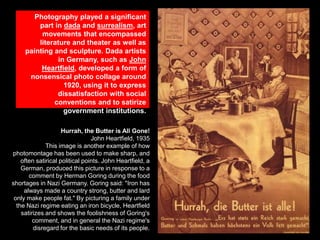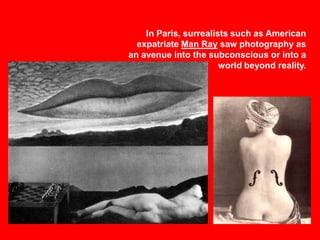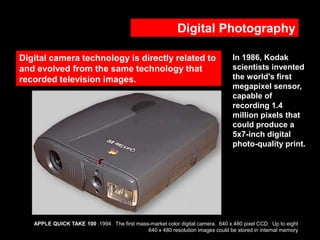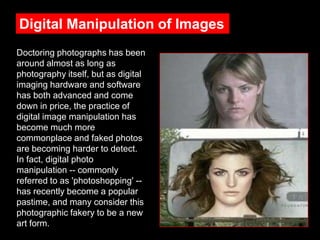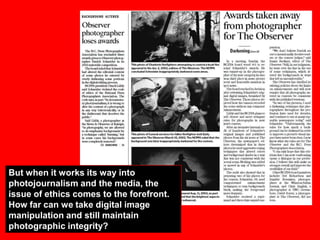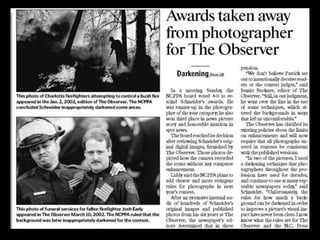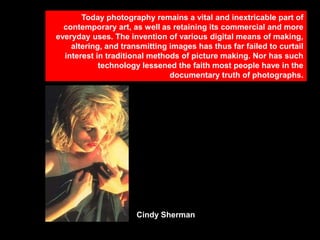History of photography
- 2. photographs.. preserve personal memories inform us of public events
- 3. they provide a means of identification… and of glamorisation..
- 4. views of far-off places on Earth and in space
- 5. as well as microscopic scenes from inside and outside the human body
- 6. Many specialised commercial categories, including fashion, product, and architectural photography, also fit under the broad umbrella that defines photography‟s function in the world today….
- 7. To mid-19th-century observers, photography seemed capable of capturing the world whole rather than describing and interpreting it as drawing did. They called it the “mirror with a memory.” Dr. Oliver Wendell Holmes who coined the phrase „Mirror with a Memory‟ But 20th-century critics have argued whether photography is indeed a direct trace of experience, like the mark of a footprint in the sand, or instead a reflection of the photographer‟s particular point of view.
- 8. Photography‟s role in the visual arts is also a matter of debate. From the start, the photographer‟s camera was seen as a challenger to the painter‟s brush. Its ability to effortlessly render tones, detail, and perspective effectively put an end to the practice of certain forms of painting, such as portrait miniatures.
- 9. It is believed today that photography created an impetus for painters to forsake straightforward description in favour of more interpretive or abstract styles, such as impressionism, cubism, and abstract expressionism.
- 10. Before mentioning the stages that led to the development of photography, there is one amazing, quite uncanny prediction made by a man called de la Roche (1729- 1774) in a work called Giphantie. In this imaginary tale, it was possible to capture images from nature, on a canvas which had been coated with a sticky substance. This surface, so the tale goes, would not only provide a mirror image on the sticky canvas, but would remain on it. After it had been dried in the dark the image would remain permanent. The author would not have known how prophetic this tale would be, only a few decades after his death.
- 11. "Photography" is derived from the Greek words photos ("light") and graphein ("to draw") The word was first used by the scientist Sir John F.W. Herschel in 1839. It is a method of recording images by the action of light, or related radiation, on a sensitive material.
- 12. camera obscura the camera obscura developed out of the simple, lens-less 'pinhole camera' which was used, perhaps a 1,000 years ago, to project an image of the sun and safely view eclipses. The incorporation of a lens in the seventeenth century (or maybe even earlier) produced a much brighter image and the camera obscura, as we know it today, was born.
- 13. the camera obscura is based on a simple principle. If you go into a dark room (thus the name, the Latin camera, "room", and obscura, "dark") and punch a small hole in the wall, the image outside will be projected inside. Light from only one part of a scene will pass through the hole and strike a specific part of the back wall. The projection is made on paper on which an artist can then copy the image if desired. The principle of the camera obscura can be demonstrated with a rudimentary type, just a box with a hole in one side.
- 14. During the Victorian era many seaside resorts had a camera obscura which was usually set up in a small octagonal building near the beach or on the pier. Inside, the visitor could watch a moving colour picture of the view outside.
- 15. The Music Lesson. 1600’s There is speculation that Vermeer used a camera obscura for his paintings
- 16. Photography as a useable process goes back to the 1820s with the development of chemical photography. The first permanent photograph was an image produced in 1826 by the French inventor Nicéphore Niépce. However, the picture took eight hours to expose, so he went about trying to find a new process. Nicéphore Niépce's earliest surviving photograph, c. 1826. This image required an eighthour exposure, which resulted in sunlight being visible on both sides of the buildings.
- 17. Daguerreotypes Working in conjunction with Louis Daguerre, they experimented with silver compounds based on a Johann Heinrich Schultz discovery in 1724 that a silver and chalk mixture darkens when exposed to light. First daguerreotype Niépce died in 1833, but Daguerre continued the work, eventually culminating with the development of the daguerreotype in 1839, reducing the exposure time down to half an hour.
- 18. The daguerreotype plate was made by brazing or coating a copper plate with silver - silver being the photographic emulsion. The image was able to capture a very fine, rich detail – superb even by today's standards. The technique is still reproduced by devotees today.
- 19. The low-cost daguerreotype became so popular that, by the end of 1839, Paris newspapers were referring to a new disease called Daguerreotypomania. People were by far the most common photographic subject of the 19th century. Photographic portraits were much less expensive than painted ones, took less of the sitter’s time, and described individual faces with uncanny accuracy. So great was the sense of presence in these pictures that photographers were often called on to take portraits of the recently deceased, a genre now known as postmortem portraits.
- 20. The Daguerreotype process, though good, was expensive, and each picture was a once-only affair. That, to many, would not have been regarded as a disadvantage; it meant that the owner of the portrait could be certain that he had a piece of art that could not be duplicated. If however two copies were required, the only way of coping with this was to use two cameras side by side. There was, therefore, a growing need for a means of copying pictures which daguerreotypes could never satisfy.
- 21. Different, and in a sense a rival to the Daguerreotype, was the Calotype invented by William Henry Fox Talbot, which was to provide the answer to that problem. the calotype negative provided the first practical method of producing prints on paper from a camera exposure
- 22. The earliest paper negative we know of was produced in August 1835; it depicts the now famous window at Lacock Abbey, his home. The negative is small (1" square), and poor in quality, compared with the striking images produced by the Daguerreotype process. However, the great advantage of Talbot's method was that an unlimited number of positive prints could be made. By 1840, Talbot had made some significant improvements, and by 1844 he was able to bring out a photographically illustrated book entitled "The Pencil of nature."
- 23. Interest in daguerreotypes dwindled in Europe after 1851, when English photographer Frederick Scott Archer invented the collodion, or wetplate process. This was a negative-topositive process, but because the negatives were made of smooth glass rather than paper, the collodion process produced much sharper images.
- 24. Using the collodion method, French painter and photographer Adolphe Disdéri in 1854 invented the carte-de-visite, a form of photographic calling card, which soon became the new rage.
- 25. Photographers using the collodion, or wet-plate, process hauled their large cameras, tripods, and portable darkrooms to the farthest reaches of Europe‟s imperial quest in the years between 1850 and 1870.
- 26. The Civil War in the United States (1861-1865) was the first war to be thoroughly recorded by photography Matthew Brady
- 27. As industrialization came to define Western life in the 19th century, industry employed photography to portray its successes and strengths. For example, in 1857 British photographer Robert Howlett took pictures of the British steamship Great Eastern, the largest vessel of its day.
- 28. In addition to recording the construction of railroads, ships, buildings, and bridges, photography proved useful to medicine and the social sciences Doctors wanted beforeand-after pictures of wounded Civil War soldiers to study the effects of amputation and invasive surgery…
- 29. Psychologists studied photographs of mental patients in an attempt to visually discern their disorders. Photographers recorded the features of criminals, not only as a means of identification, but also in an effort to identify physical characteristics, which criminologists then believed might correspond with criminal behaviour.
- 30. The development of faster cameras in the 1870s spurred scientists and others to use photography in the study of human and animal movement. In 1878 Muybridge used a series of photographs of a galloping horse to demonstrate to the world that the animal lifts all four feet off the ground at once.
- 31. French physiologist Etienne-Jules Marey also followed Muybridge‟s example and devised a special camera to record sequential photographs on a single plate. The resulting photographs showed an echoing trail of images that recorded the subject‟s movement in both time and space. Marey used this method to develop insights into the flight of birds, human movement, and the workings of the human eye.
- 32. In the last quarter of the 19th century the camera helped record the plight of the dispossessed, displaced, and overlooked. One of the earliest attempts to document urban poverty was made by Scottish photographer Thomas Annan, who aimed his camera at the empty, unsanitary alleyways of Glasgow in 1868 City officials commissioned Annan’s documentation to justify replacement of Glasgow’s unsavory slums with new development.
- 33. As photography celebrated its 50th anniversary in 1889, the average person was familiar with what photographs looked like and probably kept some at home, but few people took photographs themselves. In addition, most photographs existed as unique originals, because copies were still difficult to make. All this soon changed as a result of two important introductions: the simple-to-use Kodak camera and the halftone printing process.
- 34. The use of photographic film was pioneered by George Eastman, who started manufacturing paper film in 1885 before switching to celluloid in 1889. His first camera, which he called the "Kodak," was first offered for sale in 1888. It was a very simple box camera with a fixed-focus lens and single shutter speed, which along with its relatively low price appealed to the average consumer. The Kodak came pre-loaded with enough film for 100 exposures and needed to be sent back to the factory for processing and reloading when the roll was finished.
- 35. In 1900, Eastman took massmarket photography one step further with the Brownie, a simple and very inexpensive box camera that introduced the concept of the snapshot. The Brownie was extremely popular and various models remained on sale until the 1960s.
- 36. The snapshot expanded photography‟s territory to include casual family scenes, candid views of everyday life, and instantaneous images that stopped motion in midair. The Snapshot The photographs of Frenchman Jacques Henri Lartigue, who began taking snapshots at the age of six, best exemplify this. In this snapshot, taken when he was ten, his teenage cousin appears suspended over a flight of stairs, miraculously posing for the camera in the middle of her flying leap. Originally a hunting term for shooting from the hip
- 37. 35mm As early as 1905, Oscar Barnack had the idea of reducing the format of negatives and then enlarging the photographs after they had been exposed. As development manager at Leica, he was able to put his theory into practice. He took an instrument for taking exposure samples for cinema film and turned it into the world's first 35 mm camera: the 'Ur-Leica'.
- 38. As the technology for reproducing photographs improved in the first decade of the 20th century, a new world of images began to make the world seem smaller and its manufactured goods more desirable. Along with motion pictures, which the Lumière brothers of France introduced to the world in 1895, photographs in reproduction led to new concepts of celebrity, culture, advertising, and entertainment, all of which depended on the availability of a mass audience…..
- 39. One example of the new visual culture provided by photomechanical reproduction is the birth of picture magazines, so called because their contents were defined as much by photographs as by text. National Geographic magazine became hugely popular because of it‟s exotic photographs from around the world. It was one of the first publications to use colour photography. traditional butter making in the Palestine, from March 1914 National Geographic
- 40. Fashion photography developed along with the new picture magazines. Confined at first to studio portraits of society women in their finery, it turned to professional models and professional photographers to enliven images and entice the reader. Cecil Beaton
- 41. The new approach to photography in the editorial content of magazines was matched by an increasingly sophisticated use of photography in advertisements. Steichen. Steinway & Sons piano advertisement [Mother & son]
- 42. Photography played a significant part in dada and surrealism, art movements that encompassed literature and theater as well as painting and sculpture. Dada artists in Germany, such as John Heartfield, developed a form of nonsensical photo collage around 1920, using it to express dissatisfaction with social conventions and to satirize government institutions. Hurrah, the Butter is All Gone! John Heartfield, 1935 This image is another example of how photomontage has been used to make sharp, and often satirical political points. John Heartfield, a German, produced this picture in response to a comment by Herman Goring during the food shortages in Nazi Germany. Goring said: "Iron has always made a country strong, butter and lard only make people fat." By picturing a family under the Nazi regime eating an iron bicycle, Heartfield satirizes and shows the foolishness of Goring's comment, and in general the Nazi regime's disregard for the basic needs of its people.
- 43. In Paris, surrealists such as American expatriate Man Ray saw photography as an avenue into the subconscious or into a world beyond reality.
- 44. Digital Photography Digital camera technology is directly related to and evolved from the same technology that recorded television images. In 1986, Kodak scientists invented the world's first megapixel sensor, capable of recording 1.4 million pixels that could produce a 5x7-inch digital photo-quality print. APPLE QUICK TAKE 100 .1994. The first mass-market color digital camera. 640 x 480 pixel CCD. Up to eight 640 x 480 resolution images could be stored in internal memory
- 45. Today, the technology is massively advanced, with high res cameras even incorporated as commonplace in mobile phones
- 46. Digital Manipulation of Images Doctoring photographs has been around almost as long as photography itself, but as digital imaging hardware and software has both advanced and come down in price, the practice of digital image manipulation has become much more commonplace and faked photos are becoming harder to detect. In fact, digital photo manipulation -- commonly referred to as 'photoshopping' -has recently become a popular pastime, and many consider this photographic fakery to be a new art form.
- 47. But when it works its way into photojournalism and the media, the issue of ethics comes to the forefront. How far can we take digital image manipulation and still maintain photographic integrity?
- 49. Today photography remains a vital and inextricable part of contemporary art, as well as retaining its commercial and more everyday uses. The invention of various digital means of making, altering, and transmitting images has thus far failed to curtail interest in traditional methods of picture making. Nor has such technology lessened the faith most people have in the documentary truth of photographs. Cindy Sherman

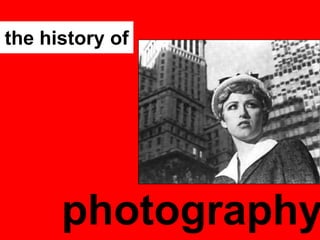
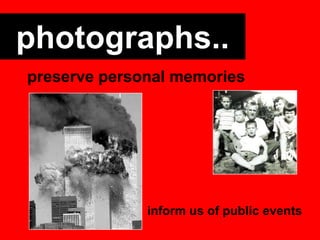


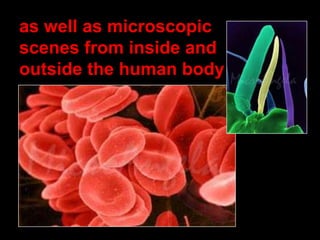
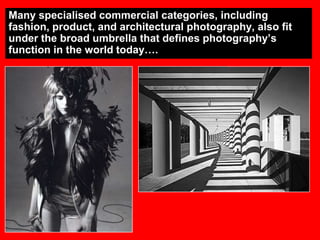
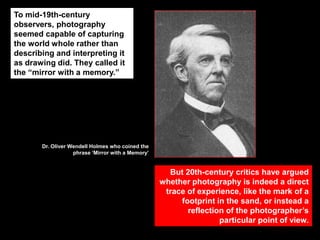
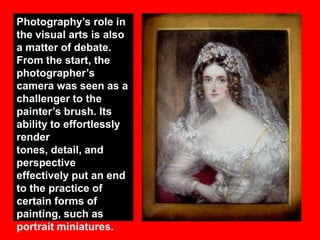
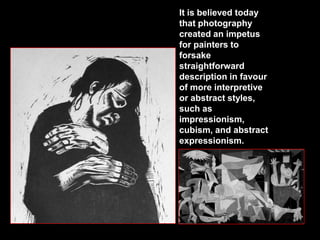
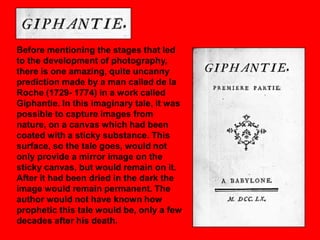
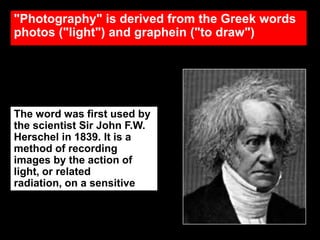
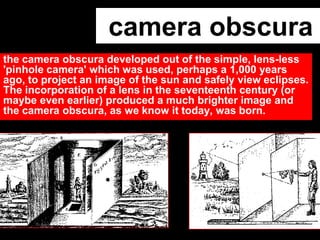
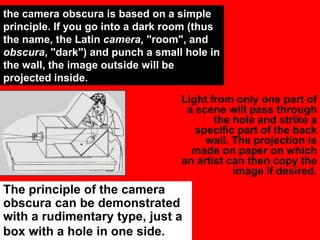
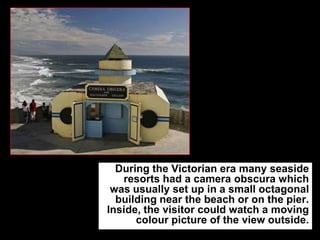
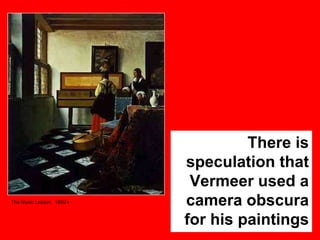

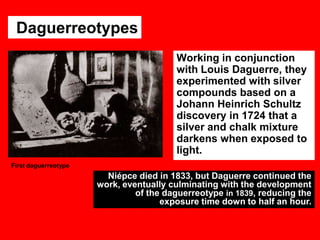
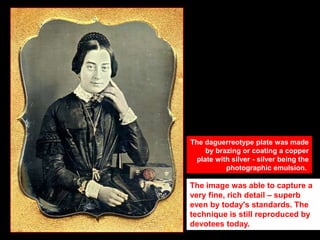
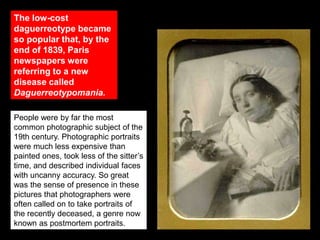
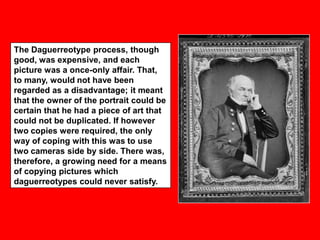
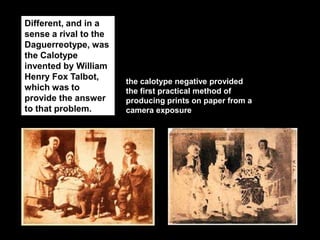
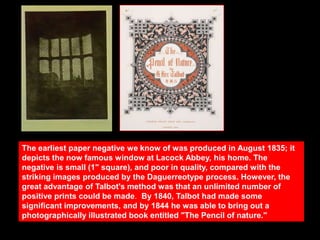
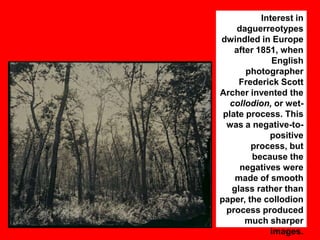
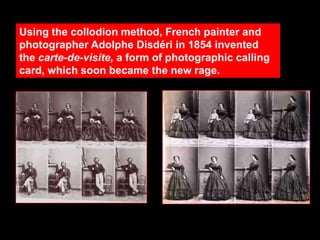
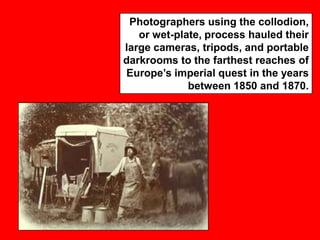
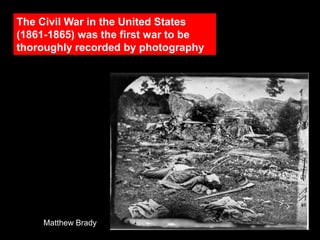
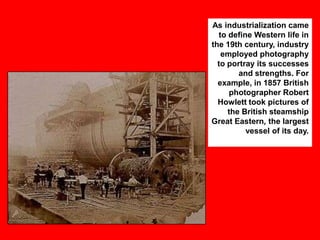
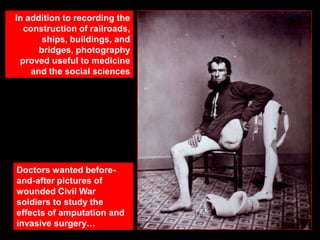

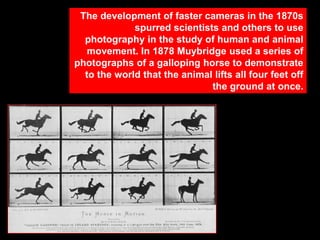
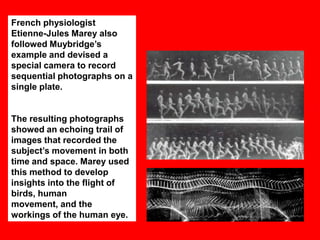
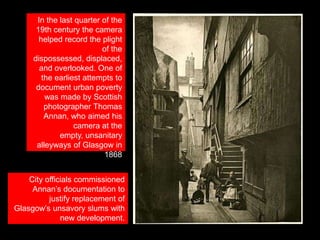
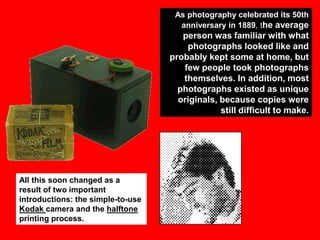
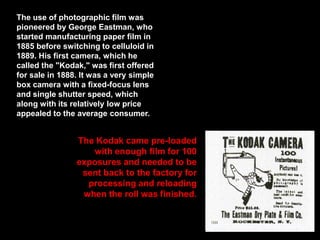
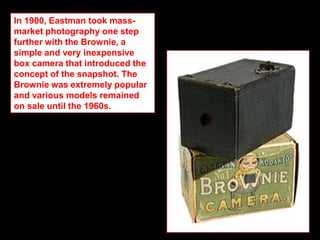
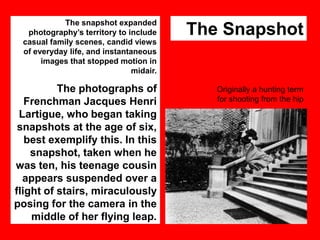
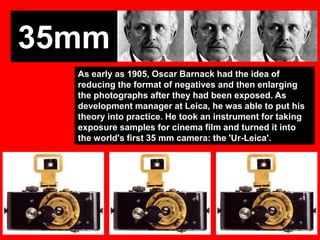
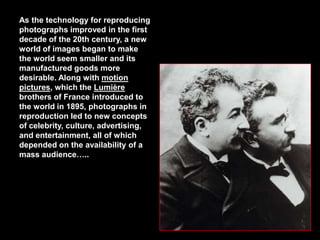

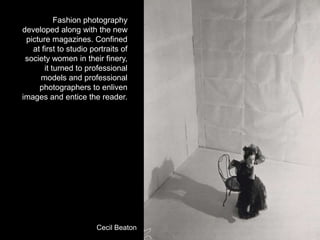
![The new approach to
photography in the editorial
content of magazines was
matched by an increasingly
sophisticated use of
photography in advertisements.
Steichen. Steinway & Sons piano advertisement [Mother & son]](https://image.slidesharecdn.com/historyofphotography-140128064155-phpapp01/85/History-of-photography-41-320.jpg)
